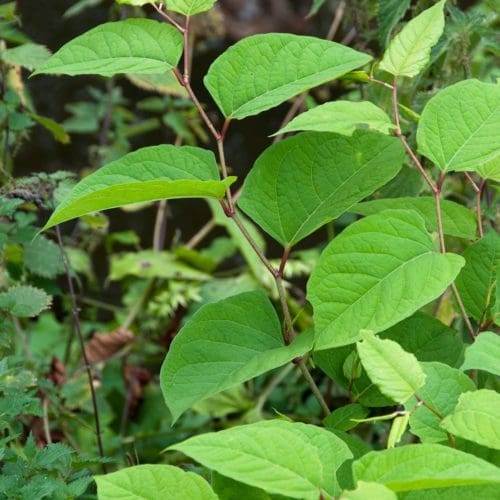
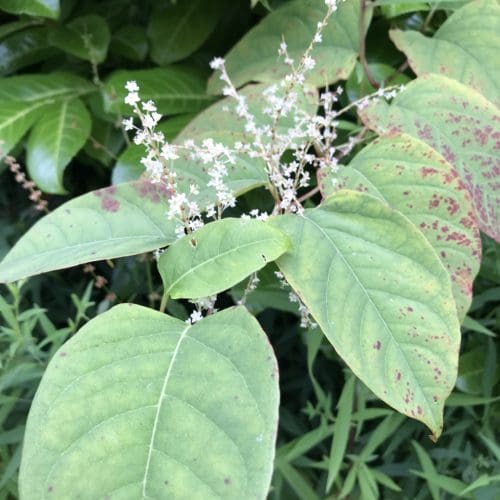

Japanese knotweed (Fallopia japonica), AKA: Japanese Bamboo, Pysen saethwr (Welsh), Polygonum cuspidatum, Reynoutria japonica.
This plant has a bamboo like stem, with purple speckles and roughly triangular green leaves between 10-15cm long, on a zig-zag twig. When it dies back in winter it leaves dead upright canes which are very distinctive. It has an extensive root system of rhizomes, making it very difficult to remove. Roots can grow up to 3m deep, and travel up to 7m laterally in all directions.
It was introduced from the far East to Europe in 1849, first being recorded in the wild in GB in South Wales in 1886. Japanese knotweed was considered an ornamental “architectural” plant and widely grown in larger gardens and parks. It was also thought to have been planted by local governments and businesses to shore up embankments and pathways, as it was believed to protect the ground from mudslides and movement.
It tends to grow on disturbed ground, on riverbanks, road sides, waste land and in urban areas. Occasionally it is found in woodland around the lower Wye Valley.
With the exception of a few unusual hybrids, Japanese knotweed cannot yet produce viable seed in the UK and, so far, every plant appears to be female. It is spread solely by vegetative means, either fragments of rhizome or stem, spread by natural means or by humans.
Japanese Knotweed is listed under Schedule 9 to the Wildlife and Countryside Act 1981 with respect to England, Wales and Scotland. As such it is an offence to plant or otherwise cause Japanese knotweed to grow in the wild. Under the Environmental Protection Act 1990, Japanese Knotweed is classified as controlled waste.
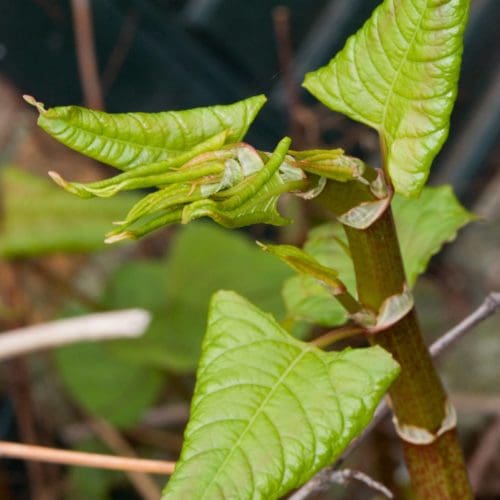

Japanese knotweed can form dense stands which stops native flowers and shrubs from growing. However, the actual impact of this is poorly researched as it usually grows on sites that are already degraded and bare of other plants.
It does alter the habitat structure and wildlife of a river bank, which is known to directly impact on salmonid fisheries, both due to restricting access for angling and hindering conservation efforts of rivers.
The rhizomes of the plant are extremely tough and re-grow readily from tiny fragments. It can grow through foundations of houses and pavements and this has led to the plant having a high economic impact. A 2018 survey estimated that this species has knocked £20 billion off the total value of the UK property market.
The total nationwide eradication of knotweed is estimated to cost £1billion.
There’s also a concern that chemical treatments are losing their potency as many invasives develop resistance, plus ever more stringent regulations might curtail the use of currently effective herbicides.
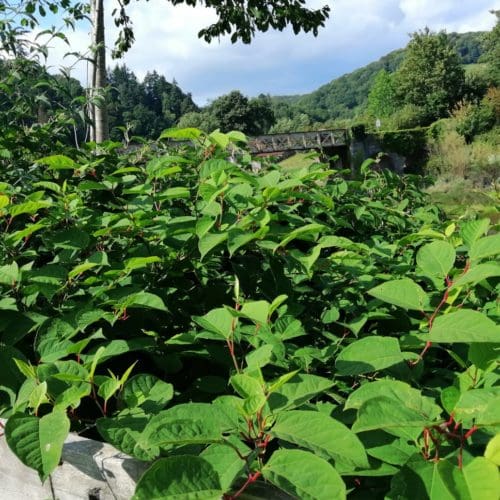

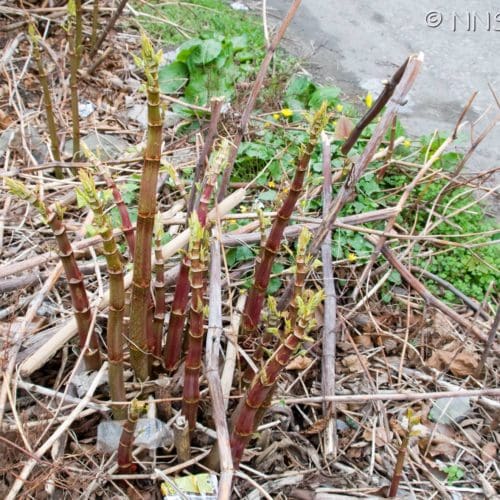

We are working very closely with our local communities, tapping into the local knowledge and gaining landowner consent and support to access knotweed sites. We’re logging all reports on our Geographic Information System (GIS) once we’ve ground-truthed the report and we’re getting an increasingly detailed picture of the extent of this species.
We then share site information with our specialist contractors who carry out the appropriate treatment for each site. Given how hard it is to fully eradicate Japanese knotweed, research suggests the only effective way of controlling it is to use Glyphosate-based herbicide. Current guidance recommends the application of a foliar spray when the plant is in full flower (late August – early October). The herbicide is taken down the stems as the plants die back at the start of the winter which impacts on that rhizome network. Spraying in the spring, when the sap is rising, is no longer recommended as the herbicide is unlikely to reach the rhizomes.
Our contractors spray stands of knotweed using knapsack sprayers, but where there are only a few sprigs stem injection is used. Most of the herbicide treatment is next to water so the necessary permissions are obtained from Environment Agency or Natural Resources Wales.
While initial success can be achieved in the first year of treatment, at least some of the root will remain and will grow to form a new stem. So we have been following up and assisting landowners with subsequent treatment. The average time for a chemical treatment programme is 3-5 years.
As a result of our increasing knowledge and by securing further funding we have scaled up the project from 60 knotweed sites in 2019 to around 120 Japanese knotweed sites in 2020, working across 15 local communities. This year promises to be even bigger as we’ve been able to extend WISP’s reach to include even more communities.
Our mapping will also enable us to monitor the effectiveness of our control work and we are already starting to see records reducing in abundance.
Report it! Please report any Japanese knotweed sightings to us so we can gain a better understanding of the distribution of this species around the lower Wye Valley, and we might be able to add it to our control schedule. Visit our Report it page for more details. And if you’re a landowner with it growing on your land and would like our help with tackling it please do complete and submit our Landowner Consent form.
Please DO NOT mow, strim or cut your Japanese knotweed. Repeatedly cutting with a mower will not kill it, the plant will simply re-grow from the root. Strimming it will spray plant fragments over a wide area which are likely to take root or flow downstream if near a watercourse and take root in neighbouring land.
If you have chosen to control the plant by cutting the stems a number of times each year then it has been shown that this method can take over 10 years to weaken the rhizomes enough to kill it. Plus you have the problem of disposing of a ‘controlled waste’ on your hands each time you take those cuttings.
Please DO NOT try to dig it up. The surrounding area will be contaminated with the roots and it only takes a discarded 2cm piece of root to start a new plant.
Photos courtesy of GB NNSS and Wye Valley AONB team